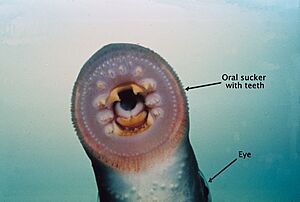River lamprey facts for kids
Quick facts for kids River lamprey |
|
|---|---|
 |
|
| Conservation status | |
| Scientific classification | |
| Synonyms | |
|
The Western River Lamprey (scientific name: Lampetra ayresii) is a type of lamprey. It is also known as the river lamprey. These unique fish live in the eastern Pacific Ocean. You can find them from Alaska all the way down to California, USA.
Western River Lampreys can live in both salty ocean water and fresh water. They are found in lakes, rivers, and creeks. In rivers, they usually stay in the lower parts of the system. This lamprey is a predator. It eats other fish that are about 10 to 30 centimeters long. It uses its round, sucker-like mouth to attach to its prey. Adult Western River Lampreys usually grow to about 21 centimeters long. Some can even reach up to 31 centimeters!
What Does a Western River Lamprey Look Like?
Western River Lampreys have a long body. They have a round mouth but no jaws. Their mouth has two teeth, plus one tooth on their tongue. They also have three points on each side tooth plate. They do not have any teeth at the back of their mouth.
These lampreys do not have scales. Their bodies are usually dark brown. Their bellies are yellow, and their heads are silver. The areas around their gill openings and lower sides are also silver.
It is very hard to tell young Western River Lampreys apart from other lamprey types. For example, they look almost exactly like young Pacific lamprey and western brook lamprey.
Western River Lamprey Life Cycle
Western River Lampreys live for about 6 to 7 years. They spend most of their lives in fresh water. They only live in the ocean for about 10 weeks.
Their life starts as a tiny larva called an ammocoete. These larvae burrow into the bottom of streams. They eat by filtering tiny bits of food from the water. This larval stage can last for 2 to 7 years.
After this, they change into a juvenile stage called macropthalmia. This change starts between July and April. It can take a long time, up to 9 or 10 months. This is the longest change for any lamprey!
Once they have changed, they swim to the ocean as adults. This usually happens between May and July. They spend about 10 weeks in the ocean. During this time, they feed on other fish. They grow very quickly and reach their full size.
After feeding, they swim back to fresh water. They go to special areas to lay their eggs. They probably like areas upstream with gravel bottoms. Both male and female lampreys move stones to build their nests. Each female can lay between 11,400 and 37,300 eggs! After the eggs are laid and fertilized, the adult lampreys die.
What Do Western River Lampreys Eat?
When the river lamprey is a young ammocoete, it is a filter feeder. It eats tiny plants called algae and dead bits of material.
When it becomes an adult, it starts to feed on other fish. This happens once it reaches about 16.2 centimeters long. It mainly eats fish that are 10 to 30 centimeters long. These often include herring and salmon.
To eat, the lamprey attaches to the back of its prey. It usually latches on above the fish's side line. It uses its round mouth to suck on the muscle tissue of the fish.



